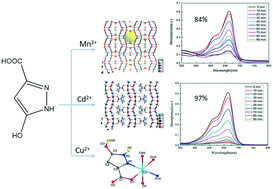Synthesis, structure and photocatalytic properties of coordination polymers based on pyrazole carboxylic acid ligands†
Abstract
Three new compounds, namely, [Mn(hpcH)(H2O)2]·H2O (1), [Cd(hpcH)(DMF)(H2O)] (2), [Cu(hpcH2)2(H2O)2] (3), (hpcH3 = 5-hydroxy-1H-pyrazole-3-carboxylic acid) were solvothermally synthesized and characterized in detail. Compounds 1 and 2 are coordination polymers (CPs), exhibit two-dimensional (2D) layered structures and crystallize in monoclinic lattices with the C2/c and P21/c space groups, respectively. Compound 3 shows a 3D supramolecular structure constructed from six-coordinated mononuclear Cu2+ through hydrogen bonds and π–π stacking interactions. The hpcH3 ligand behaved in different coordinated modes in the three compounds. It lost two protons in compounds 1 and 2 and one proton in compounds 3. Furthermore, the photocatalytic degradation properties of compounds 1 and 2 were investigated. The results indicate that 1 and 2 show excellent photocatalytic activities for methylene blue (MB) under visible light. The photocatalytic degradation efficiency of 2 reached 96.7% in 90 minutes. The possible photocatalytic mechanisms displayed by CPs 1–2 for the photodegradation of MB have been addressed through the trapping experiment and theoretical calculations.



 Please wait while we load your content...
Please wait while we load your content...